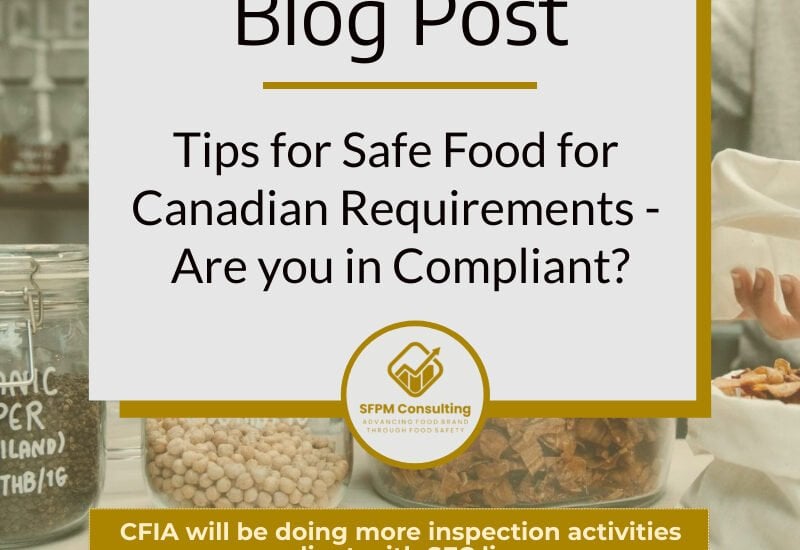Tips for Safe Food for Canadian Requirements -Are you in Compliant?
- July 15, 2020
- Posted by: Felicia L
- Categories: Food Exporter, Food Importer, Food Safety, SFCR, SFCR, Start-Up


Indeed, there are a number of food safety documents that we use in our day-to-day operations to ensure compliance with multiple regulatory and voluntary certifications. So, it did makes sense to incorporate the requirements into an existing program.
The SFCR requires compliance in terms of three main areas:
- Licensing
- Preventative Control Program (PCP)
- Recall and Traceability
Tips #1: Knowing the ins and outs of the SFCR program licensing
For all facilities that manufacture, process, treat, preserve, grade, package or label food, you may be subjected to the requirement to obtain an SFC license for your operations.
Preventative Control Program (PCP)
Few key points for the PCP program are listed below:
- Written program
- Demonstrate risks to food and food animals are identified and controlled based on HACCP principles. ie. retaining the scientific approach of identifying and controlling risks.
- Measures to ensure the packaging, labelling, grades and standards of identity are met.
Manufacturers:
For local manufacturers, you must have assessed ingredients, processes, process flow, traffic flow and hazards assessment to determine the preventative food safety control requirements. Further, ensure that the hazards are mitigated and documented properly.
Importer:
For importers, a PCP describes how the importer and its foreign suppliers are meeting preventive food safety control requirements.
Tips #2: Develop or assessed a food safety management system
Whether you are manufacturing food in Canada, exporting food from Canada or exporting food out of Canada, the food produced in Canada and brought into Canada must meet SFCR requirement: Section 50 -89
If you are a local food manufacturer, to meet SFCR requirements section 50 – 89, you must ensure that you have
- A properly developed and implemented food safety procedures
- Records and evidence that you follow and meet SFCR requirements
If you are a food importer, you must ensure that the foreign facility meets the food safety management system requirements, similar to section 50-89. Typically, through reviewing the food importer’s food safety management systems and whenever possible, food safety audit report or similar. This is very similar to reviewing a Supplier Approval program.
If you don’t have experience building the required food safety program, our SFCR Templates is a great start:
Our SFCR Program Template is an excellent way to speed up compliance with the Safe Food for Canadian regulations. Covering over 100++ procedures and forms, this SFCR template bundles worth $2, 000 or more in time, to write the procedures from scratch, easily customizable and usable. It is an excellent choice to get SFC procedures written in less than 2 weeks’ time.
Tips #3: Write your Recall and Traceability Program
Traceability program helps to identify and recall food that does not meet SFCR requirements in the marketplace. The traceability program also involves retailers and persons who send or convey food products interprovincially. The requirement concepts are simple -tracing one step forward (customer) and one step backward (supplier). Tracing for customer often stop at the retail level ie. if you sell your food products to Loblaw, you traceability process ends there.
You must be able to ensure that you are able to trace all products that you manufacture, process, pack and distribute. CFIA requires traceability to be conducted within 24 hours.
SFCR requirement: Section 90 -92
Tips #4: Write your Customer Protection Plan
What is a customer protection plan? A customer protection plan is a plan to document how you are going to meet the labelling requirements for food sold in Canada -this of course includes the requirements for bilingual declaration, nutritions facts table, ingredient list, weight declaration, common name, product claims etc.
Check out these industry guidelines on how to comply with food labelling requirements in Canada:
https://inspection.canada.ca/food-label-requirements/labelling/industry/eng/1383607266489/1383607344939
You must ensure the food products labels accurately describes the product’s information. All claims must be substantiated.
The Bottomline
SFCR requirements are not new and are important to ensure that the food products that we eat are safe. It is also important to ensure that imported food follows the same requirements. As a result, the following must be available in writing, implemented (followed) and documented:
- Preventative Control Plan -Plan to ensure that risks associated with the specific food products (manufactured or imported) are mitigated. It is specific to products, manufacturers and distribution channels.
- Manufacturer’s Food Safety Procedures or evaluation -Food manufacturers must have a properly developed and implemented food safety management system. For food importers, the food safety management systems must be evaluated.
- Traceability Plan -All food manufacturers or importers must have a traceability program in place so that a withdrawal or recall can be conducted smoothly and prevent tainted or contaminated products left in the market.
